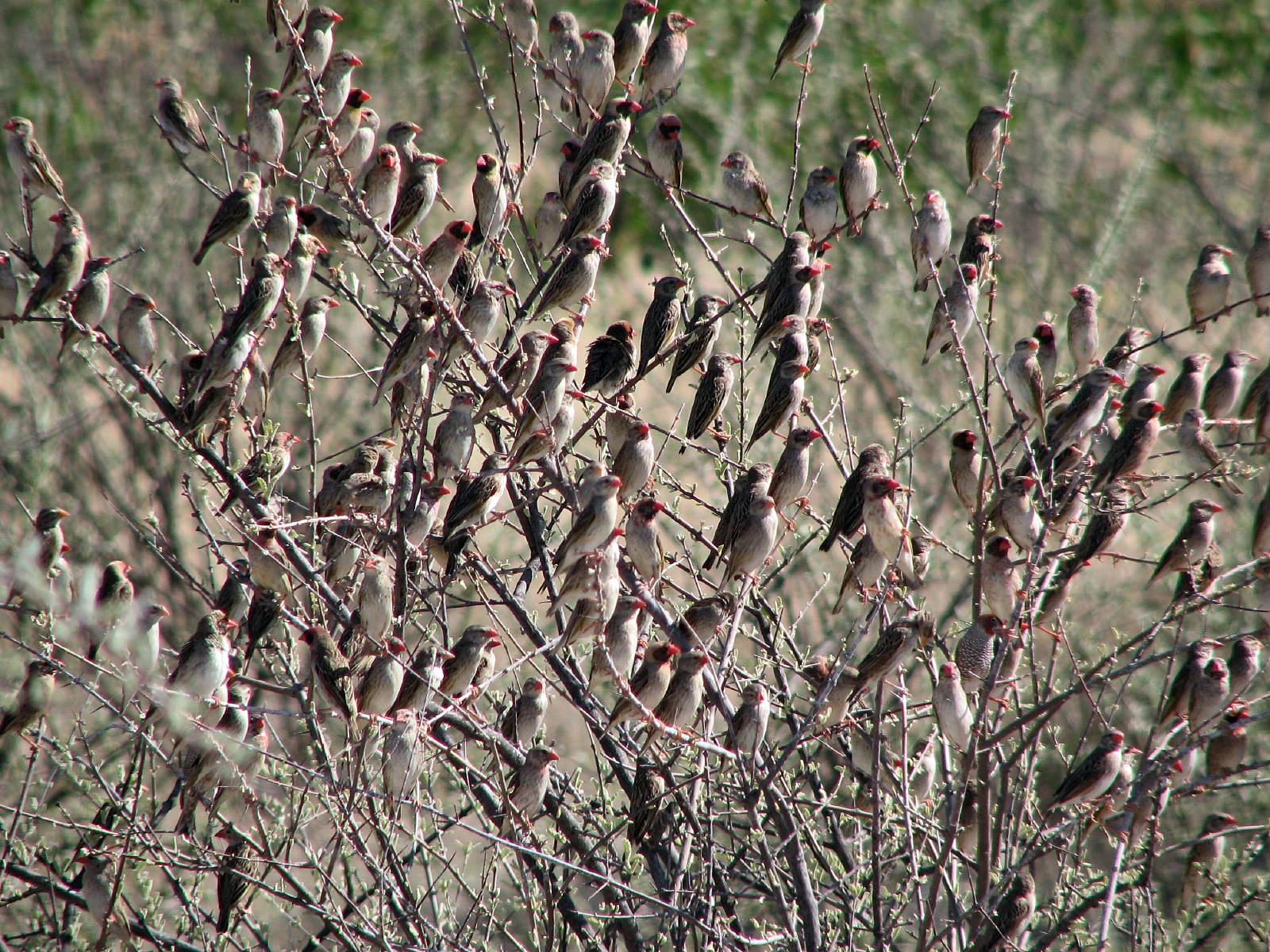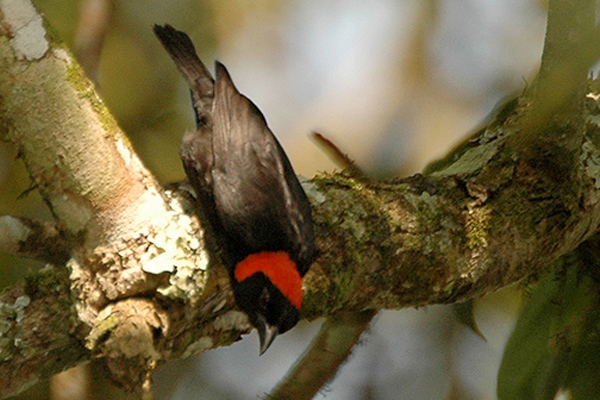|
Ploceidae
Ploceidae is a family of small passerine birds, many of which are called weavers, weaverbirds, weaver finches, or bishops. These names come from the nests of intricately woven vegetation created by birds in this family. In most recent classifications, the Ploceidae are a clade that excludes some birds that have historically been placed in the family, such as some of the Old World sparrow, sparrows, but which includes the monotypic subfamily Amblyospizinae. The family is believed to have originated in the mid-Miocene. All birds of the Ploceidae are native to the Old World, most in Africa south of the Sahara, though a few live in tropical areas of Asia. A few species have been Introduced species, introduced outside their native range. Taxonomy and systematics The family Ploceidae was introduced (as Ploceïdes) by Swedish zoologist Carl Jakob Sundevall in 1836. Phylogenetic studies have shown that the family is sister taxon, sister to a clade containing the families Viduidae and Estr ... [...More Info...] [...Related Items...] OR: [Wikipedia] [Google] [Baidu] |
Pseudonigrita
''Pseudonigrita'' is a genus of sparrow-like birds in the weaverbird family. Extant Species It contains two species, which are both found in eastern Africa: Taxonomy French naturalist Charles Lucien Bonaparte described the grey-capped social weaver as ''Nigrita arnaudi'' in 1850, based on a specimen collected by the French explorer Joseph Pons d'Arnaud around 1841 near Juba on the White Nile. In 1884, the black-capped social weaver was first described by German East-Africa explorer Gustav Fischer and German ornithologist Anton Reichenow as ''Nigrita cabanisi'', based on a specimen collected in 1883 by Fischer in the Pare Mountains. In 1903, Reichenow assigned both species to his newly erected genus ''Pseudonigrita'', because he considered ''P. arnaudi'' and ''P. cabanisi'' related to weaverbirds (Ploceidae), while the other species '' Nigrita bicolor'', '' N. canicapillus'', '' N. fusconota'' and '' N. luteifrons'' are negrofinches assigned to the estrildid finche ... [...More Info...] [...Related Items...] OR: [Wikipedia] [Google] [Baidu] |
Plocepasser
The sparrow-weavers (''Plocepasser'') are a genus of birds in the family (biology), family Ploceidae (weavers), but some taxonomic authorities place them in the family Passeridae (Old World sparrows). Taxonomy and systematics The genus ''Plocepasser'' contains the following species: Phylogeny Based on recent DNA-analysis (which only included ''P. mahali''), the genus ''Plocepasser'' belongs to the group of sparrow weavers (subfamily Plocepasserinae), and is most related to the clade that consists of ''Philetairus socius'' and the genus ''Pseudonigrita''. This clade is sister group, sister to the most basic genus of the subfamily, ''Sporopipes''. Provided that genera are correct clades, the following tree expresses current insights. References External links * * Ploceidae Taxonomy articles created by Polbot {{Ploceidae-stub ... [...More Info...] [...Related Items...] OR: [Wikipedia] [Google] [Baidu] |
Ploceus
''Ploceus'' is a genus (biology), genus of birds in the Ploceidae, weaver family (biology), family, Ploceidae. They are native to the Indomalayan realm, Indomalayan and Afrotropical realms. Taxonomy and systematics Phylogeny The genus ''Ploceus'' was introduced by the French naturalist Georges Cuvier in 1816. The type species was subsequently designated as the baya weaver. The genus name is from Ancient Greek πλοκευς ''plokeus'' meaning "weaver", and is derived from the Greek word πλεκω ''plekō'' "to entwine". Based on recent DNA phenotyping, DNA-analysis, the genus ''Ploceus'' is almost certainly Polyphyly, polyphyletic. If all species currently included in the genus would remain and the genus would be made monophyletic, it would have to encompass the entire subfamily Ploceinae. The Ploceinae can be divided into two groups. In the first group, the widowbirds and bishops (genus ''Euplectes'') are sister to a clade in which the genera ''Foudia'' and ''Quelea'' ar ... [...More Info...] [...Related Items...] OR: [Wikipedia] [Google] [Baidu] |
Quelea
''Quelea'' is a genus of small passerine birds that belongs to the weaver family Ploceidae, confined to Africa. These are small-sized, sparrow- or finch-like gregarious birds, with bills adapted to eating seeds. Queleas may be nomadic over vast ranges; the red-billed quelea is said to be the most numerous bird species in the world. Taxonomy There are three species: Phylogeny Based on recent DNA-analysis, the red-billed quelea is sister to a clade that consist of both remaining species of the genus ''Quelea'', namely ''Q. cardinalis'' and ''Q. erythrops''. The genus belongs to the group of true weavers (subfamily Ploceinae), and is most related to '' Foudia'', a genus of six or seven species that occur on the islands of the western Indian Ocean. This clade is sister to the Asian species of the genus ''Ploceus ''Ploceus'' is a genus (biology), genus of birds in the Ploceidae, weaver family (biology), family, Ploceidae. They are native to the Indomalayan realm, I ... [...More Info...] [...Related Items...] OR: [Wikipedia] [Google] [Baidu] |
Anaplectes
''Anaplectes'' is a genus of African birds in the weaver family Ploceidae. Taxonomy The genus ''Anaplectes'' was introduced in 1863 by the German naturalist Ludwig Reichenbach. The type species was subsequently designated by Richard Bowdler Sharpe as ''Ploceus leuconotus'' Müller, JW 1851, now a subspecies In Taxonomy (biology), biological classification, subspecies (: subspecies) is a rank below species, used for populations that live in different areas and vary in size, shape, or other physical characteristics (Morphology (biology), morpholog ... of the red-headed weaver (''Anaplectes rubriceps''). The genus contains the following two species: * Red-headed weaver ''Anaplectes rubriceps'' * Red weaver ''Anaplectes jubaensis'' References Ploceidae Bird genera {{Ploceidae-stub ... [...More Info...] [...Related Items...] OR: [Wikipedia] [Google] [Baidu] |
Malimbus
''Malimbus'' is a genus of birds in the family Ploceidae. It was erected by the French ornithologist Louis Pierre Vieillot in 1805. The genus contains the following ten species: References Malimbus, Ploceidae Birds of the African tropical rainforest Taxa named by Louis Pierre Vieillot Taxonomy articles created by Polbot {{Ploceidae-stub ... [...More Info...] [...Related Items...] OR: [Wikipedia] [Google] [Baidu] |
Bubalornis
''Bubalornis'' is a genus of bird in the family Ploceidae. Established by Andrew Smith in 1836, it contains the following species: The name ''Bubalornis'' is a combination of the Greek words ''boubalos'', meaning "buffalo" and ''ornis'', meaning "bird". The genus Genus (; : genera ) is a taxonomic rank above species and below family (taxonomy), family as used in the biological classification of extant taxon, living and fossil organisms as well as Virus classification#ICTV classification, viruses. In bino ... got its name from the buffalo weavers' habit of following herds of African Buffalo. References External links * * Bird genera Ploceidae Taxonomy articles created by Polbot {{Ploceidae-stub ... [...More Info...] [...Related Items...] OR: [Wikipedia] [Google] [Baidu] |
Philetairus
The sociable weaver (''Philetairus socius'') is a species of bird in the weaver family, endemic to Southern Africa. It is the only species in its genus ''Philetairus''. It is found in South Africa, Namibia, and Botswana, but its range is centered within the Northern Cape Province of South Africa. The species builds large, compound, community nests, a rarity among birds. These nests are perhaps the most spectacular structure built by any bird. Taxonomy and systematics The sociable weaver was first described by ornithologist John Latham in 1790. Alternative names include the common social weaver, common social-weaver, and social weaver. Formerly, four subspecies were recognised, but the species is now considered monotypic. The sociable weaver is the only extant species in the genus ''Philetairus''. Phylogeny Based on a 2017 DNA-analysis, ''P. socius'' belongs to the group of sparrow weavers (subfamily Plocepasserinae) and is most related to the genus ''Pseudonigrita''. The ... [...More Info...] [...Related Items...] OR: [Wikipedia] [Google] [Baidu] |
Sporopipes
''Sporopipes'' is a genus of bird Birds are a group of warm-blooded vertebrates constituting the class (biology), class Aves (), characterised by feathers, toothless beaked jaws, the Oviparity, laying of Eggshell, hard-shelled eggs, a high Metabolism, metabolic rate, a fou ...s in the weaver family. Species External links * * References Ploceidae Bird genera Taxonomy articles created by Polbot {{Ploceidae-stub ... [...More Info...] [...Related Items...] OR: [Wikipedia] [Google] [Baidu] |
Village Weaver
The village weaver (''Ploceus cucullatus''), also known as the spotted-backed weaver or black-headed weaver (the latter leading to easy confusion with ''Ploceus melanocephalus, P. melanocephalus''), is a bird species in the family Ploceidae found in much of sub-Saharan Africa. It has also been Introduced species, introduced to Portugal and Venezuela as well as to the islands of Hispaniola, Martinique, Puerto Rico, Mauritius and Réunion. This often abundant species occurs in a wide range of open or semi-open habitats, including woodlands and human habitation, and frequently forms large noisy colonies in towns, villages, and hotel grounds. This Ploceidae, weaver builds a large coarsely woven bird nest, nest made of grass and leaf strips with a downward-facing entrance, which is suspended from a branch in a tree. Two or three bird egg, eggs are laid. Village weavers are Bird colony, colonial breeders, so many nests may hang from one tree. Village weavers feed principally on s ... [...More Info...] [...Related Items...] OR: [Wikipedia] [Google] [Baidu] |
Euplectes
''Euplectes'' is a genus of passerine bird in the Ploceidae, weaver family, Ploceidae, that contains the bishops and widowbirds. They are all native to Africa south of the Sahara. It is believed that all birds in the genus are probably polygyny in animals, polygynous. The genus ''Euplectes'' was introduced by the English naturalist William Swainson in 1829 with the southern red bishop as the type species. The name combines the Ancient Greek ''eu'' meaning "fine" or "good" with the Neo-Latin ''plectes'' meaning "weaver". When choosing their mates, females within this genus will often choose males with longer tail lengths, even in species with comparatively shorter tail lengths. Species The genus contains 18 species. Aviculture The yellow-crowned bishop and northern red bishop are popular in aviculture. References External links * * Euplectes, Bird genera Taxonomy articles created by Polbot Taxa named by William Swainson {{Ploceidae-stub ... [...More Info...] [...Related Items...] OR: [Wikipedia] [Google] [Baidu] |
Amblyospiza
The thick-billed weaver (''Amblyospiza albifrons''), or grosbeak weaver, is a distinctive and bold species of weaver bird that is native to the Afrotropics. It belongs to the monotypic genus ''Amblyospiza'' and subfamily Amblyospizinae. They have particularly strong mandibles, which are employed to extricate the seeds in nutlets and drupes, and their songs are comparatively unmusical and harsh. Their colonial nests are readily distinguishable from those of other weavers, due to their form and placement, and the fine strands used in their construction. They habitually fan and flick their tails. Taxonomy and systematics The generic name ''Amblyospiza'' was coined by Carl Jakob Sundevall in 1850 and means "blunt, finch", referencing the very large bill, while the specific name ''albifrons'' refers white forehead of the males. The thick-billed weaver was formally described as ''Pyrrhula albifrons'' in 1831 by the Irish zoologist and politician Nicholas Aylward Vigors from the coll ... [...More Info...] [...Related Items...] OR: [Wikipedia] [Google] [Baidu] |




